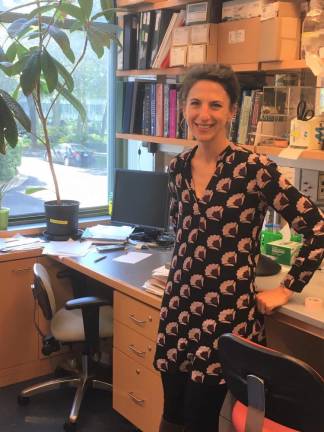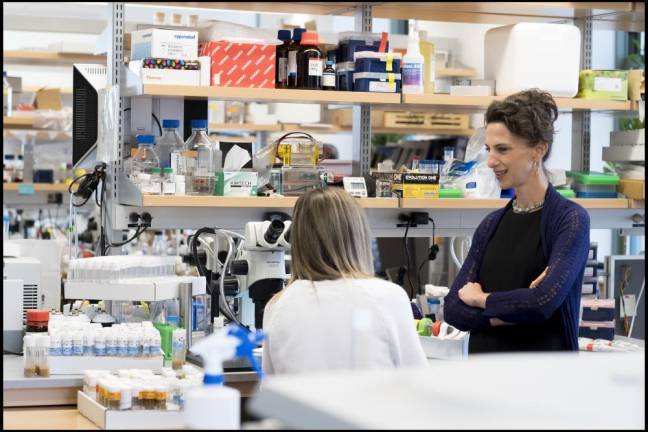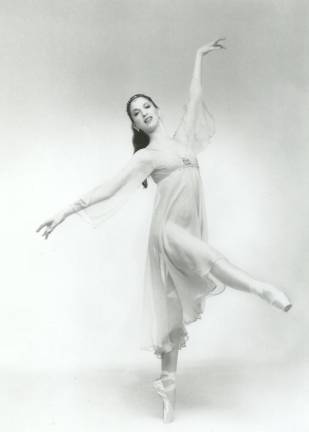Manhattan Genius
A product of New York's top schools nabs a prestigious MacArthur Foundation grant



Forging a world-class career in science takes focus, discipline, years of hard work and, in Vanessa Ruta’s case, a Metrocard.
Ruta is an award-winning neuroscientist at Rockefeller University on the Upper East Side, where her colleagues hail from California, China, Brazil, Denmark and other places around the U.S. and the globe. But Ruta has found success in her hyper-competitive field right here on her home island of Manhattan.
A graduate of Stuyvesant High School, where she was introduced to “the elegant principles of the periodic table” by chemistry teacher Matthew Litwin, Ruta, now 45, earned a B.A. in chemistry at Hunter College, followed by a Ph.D. at Rockefeller. She capped off her education doing post-doctoral research at Columbia University. To confirm her Manhattan bona fides, Ruta boasts another achievement, or should we say, non-achievement. “I feel like a true New Yorker,” she says, “because I never learned to drive.”
While she has spent most of her time between the Hudson and East rivers, Ruta’s research – she uses fruit flies to study how the brain is modified by experience – has been recognized around the world for its originality and importance. In September she received a five-year, $625,000 “genius grant” from the MacArthur Foundation, which noted her “imaginative deployment” of the advanced technology and techniques available to 21st century neuroscientists.
Ruta uses those tools to explore how the neural circuits of fruit flies govern behaviors, including instinctive ones, like how they choose mates, and learned behaviors that depend on past experience. Despite its simplicity, the fruit fly nervous system is well-established as a model for more complicated systems. Researchers use it to glean basic principles about the functions of the human brain.
Ruta was “overwhelmed and very humbled” by the award, but she is quick to dodge the genius appellation, noting that the MacArthur folks don’t use the term. “Genius comes in so many forms that it’s hard to put that label on yourself,” she says. “It’s good for some humor and it’s good to impress my son. And it’s always nice to be acknowledged for the work that you do and the work my lab has done.”
A Dancer First
Had things gone differently for Ruta in the 1990s, however, she might have ended up doing a very different kind of work, over on the West Side perhaps, at Lincoln Center. After graduating from Stuyvesant, she spent the next four years pursuing a career as a ballet dancer. She was as serious about it as she is about science today.
“If you want to be a professional dancer when you are 17 or 18, you have to have a full commitment,” says Ruta. “It’s highly competitive, it is a hard life.” When she was 21, after years of classes, auditions and performances, she realized that she was not likely to achieve her goal – a full-time contract with American Ballet Theater or the New York City Ballet.
To get some balance in her life, as she puts it, she took a chemistry class at Hunter College. It turned out to be just what she needed. “After being in the subjective ballet world, there was something really beautiful about the objective principles of basic chemistry,” she says.
Mentors and Artists
She aced the class and enrolled at Hunter full time as a chemistry major, under the guidance of Professor Charles Michael Drain. She found life as a scientist much easier than life as a dancer.
"Vanessa was an exceptional student who wanted to understand the broader impacts of chemistry on the sciences and society," says Drain, who, like Ruta, transitioned in his undergraduate years from the arts to science. Her research in his lab, on methods to discover new photo-therapeutic compounds, was published in a top journal in the field. "She brought to her research the same focus, discipline, and creativity that she had learned in the art of dance. Since we had similar experiences, we share a deep appreciation for the link between the arts and the sciences, which I think is an important part of her success."
After graduating from Hunter in 2000 Ruta moved on to Rockefeller as a Ph.D. student in the lab of Dr. Rod MacKinnon, who was awarded the Nobel Prize in Chemistry in 2003.
Ruta’s next mentor was another Nobel laureate, Columbia University scientist Richard Axel, also a Stuyvesant grad, who shared the 2004 award for medicine. Ruta did post-doctoral research in Axel’s lab. It was there that she decided to pursue neuroscience. “I think most of us are deeply fascinated by the function of our own brains and how we perceive the world around us,” she says.
Spending the early years of her career with such accomplished role models left Ruta with a sure sense of the way forward. “The scientists I deeply admire are people who have pushed themselves into new directions and are constantly pushing themselves into a place where they are a little bit uncomfortable,” she says. “They don’t settle in on one idea and just go with the easy thing.” Science is so fast moving, she adds, that “none of us really know right now what we’ll need to know in five years.”
Ruta also credits her success as a scientist to growing up surrounded by creative people. Her father was a painter, her mother a writer. During her teenage and college years the family lived in the Westbeth Artists Housing complex in Greenwich Village. “I came from a family or artists,” Ruta says. “I thought I would be an artist of some sort, and I realize that the profession I ended up in has a similar kind of process. My father painted basically every day of my life. He was such a dedicated and passionate artist. And that kind of passion and commitment is something you can obviously see in scientists. Honing your craft gives you the freedom to be very creative and expansive in your thinking.”
Life as a Woman in Science
Intellectual prowess is only one part of being a scientist, Ruta says, and she wants young people to have a better understanding of what science really involves – passion and creativity – and what the life of a scientist is like. “That would capture a broader diversity of young people interested in pursuing it,” she says.
Including young women, of course, who, even today, face unique challenges in science, which has been dominated by men for so long. And still is. Ruta was pregnant with her first child (she has a son and a daughter) when she started working with Axel in 2005. She recalls him telling her at the time that he had never had a student or post-doc who had a baby while working in his lab.
Ruta points out that the male/female ratio among science Ph.D. students is about 50-50, but that changes dramatically during the post-doc years, when many women are deciding to start families. By the time the post-docs start applying for faculty positions, she says, the male/female ratio is more like 75/25, or worse.
One simple step to address the imbalance is for academic research centers to provide subsidized childcare, says Ruta, whose entire post-doc salary went to pay for baby sitters. (Rockefeller, where women make up around 20 percent of the faculty, does subsidize childcare.)
Adding to the stress of the post-doc period for women is the professional uncertainty all young scientists experience, worrying that they may not be good enough to make it. Not even Ruta was immune to moments of doubt. “I will tell you,” she says, “I seriously considered leaving science, especially after my second child was born.”
Fortunately for all the people who will work with and be inspired by Ruta in the coming years, not to mention everyone with a brain, she decided to stay.
“The scientists I deeply admire are people who are constantly pushing themselves into a place where they are a little bit uncomfortable.” Vanessa Ruta